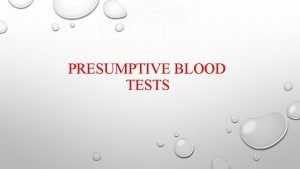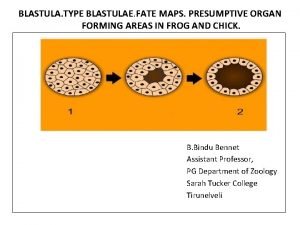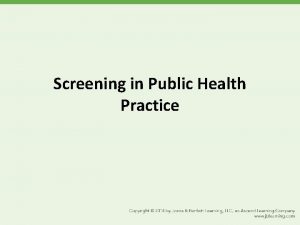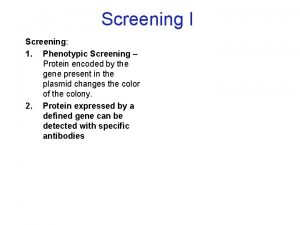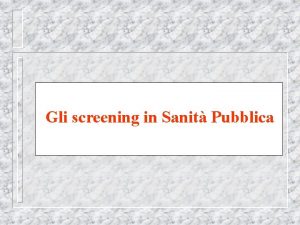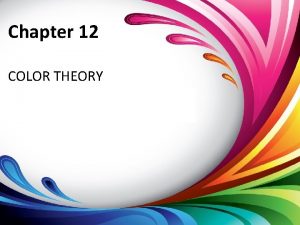IV Screening for Drugs 1 Color Tests presumptive



















- Slides: 19

IV. Screening for Drugs

1. Color Tests (presumptive) • Narrows down type of drug • Fast • Simple Cannot be used in court!

Color Test: 1) Marquis Drug Heroin Deep Purplish Red Morphine Deep Purplish Red Amphetamine Ecstasy 2) Cobalt Thiocyanate Cocaine 3) Dillie-Koppanyi Barbituates 4) Van. Urk LSD 5) Duquenois-Levine Marijuana Positive Result__

Molecular Structures of Narcotics and Stimulants amphetamine

Marquis Reagent Test for opiates (heroin, morphine, codeine), ecstasy, and amphetamines Positive results:

Cobalt thiocynate Test a. k. a. Scott Test Cocaine- Positive test = blue solution

Dillie-Koppanyi Test Positive test = violet-blue solution

Van. Urk Test Positive test = blue-purple solution Molecular Structure of LSD ( D-lysergic acid diethylamide)

Marijuana THC (tetrahydrocannabinol )

Duquenois-Levine Reagent Positive test = purple; • ibuprofen cause a false positive

2. Microcrystalline Test (confirmation) • chemical rxn between drug & a reagent (specific chemical) that produces a unique crystal precipitate • Size and shape of crystals formed are highly characteristic of specific drugs. Heroine- “K” Cocaine-cross

3. Spectrophotometry (confirmation) • UV light and IR light are absorbed by drug • The wavelengths and intensity absorbed are unique for each drug

4. GC/Mass Spectrometry (confirmation) • Sample is hit with high energy electrons that cause the drug to break apart • Each drug breaks down differently • Produces plot of subproducts • Rapid screening and wide range of drugs

Detection Period of Drugs

V. Poisons Brief History • Hemlock, 399 BC • By 17 th century, people were quite adept at using poisons to kill people, especially arsenic. • Murder by poison not popular anymore. Why? • (easier to get gun than controlled substances)

VI. Vocab Poison Naturally occurring or manufactured substance that can cause severe harm or death if ingested, inhaled, absorbed, or injected. Toxin Poisonous substance produced by certain plants, animals, or bacteria; capable of causing disease or death (subgroup of poisons).

A. Poisons 1. Generally enter the body in a single, massive dose 2. Can be counteracted by prompt treatment 3. Most organ damage is repairable (except CNS) 4. ID’ed by their symptoms 5. Many disguise themselves

B. Toxicity and Toxic Agents 1. Toxicity • degree to which a substance is poisonous or can cause harm • important factors: – – dose (how much) duration (how long) exposure (inhale, ingest, inject) nature of the drug (how it interacts with body and other substances) 2. Toxic Agents– alcohol, drugs, heavy metals, solvents & vapors, radiation, pesticides, and plant/animal toxins

C. Immunoassay • a biochemical test that measures the presence of a molecule through the use of an antibody (usually) or an antigen • used to detect a variety of drugs and poisons in saliva, urine
 Hemastix blood test
Hemastix blood test Fate map of blastula
Fate map of blastula Central pocket whorl vs plain whorl
Central pocket whorl vs plain whorl Ohio medicaid insurance
Ohio medicaid insurance Ace different tests help iq tests
Ace different tests help iq tests Kontinuitetshantering
Kontinuitetshantering Typiska drag för en novell
Typiska drag för en novell Nationell inriktning för artificiell intelligens
Nationell inriktning för artificiell intelligens Ekologiskt fotavtryck
Ekologiskt fotavtryck Shingelfrisyren
Shingelfrisyren En lathund för arbete med kontinuitetshantering
En lathund för arbete med kontinuitetshantering Adressändring ideell förening
Adressändring ideell förening Vilotidsbok
Vilotidsbok A gastrica
A gastrica Vad är densitet
Vad är densitet Datorkunskap för nybörjare
Datorkunskap för nybörjare Tack för att ni lyssnade bild
Tack för att ni lyssnade bild Att skriva debattartikel
Att skriva debattartikel Autokratiskt ledarskap
Autokratiskt ledarskap Nyckelkompetenser för livslångt lärande
Nyckelkompetenser för livslångt lärande
